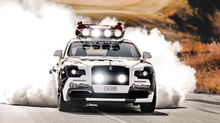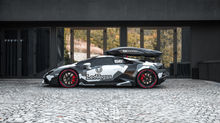FUNNY BUSINESS
- t800xron
- Sep 7, 2016
- 4 min read

Nitrous oxide, or 'NOS' as it is commonly referred to, is perhaps the only product int the tuning industry that brings about excitement, glamour abd mystique in on bottle. It is the most bang-for-buck and a nice bump in street cred.
So what is nitrous oxide? The air we breathe is made out of 21% oxygen, 78% nitrogen and 1% other gases. NItrous oxide (N20) is a colourless, odurless and non-flammable gas. It molecular struture is made up of two parts nitrogen and one part oxygen, or approximately 36% oxygen by weight. The gas is non-toxic abd when inhaled in small quantities can produce mild hysteria and laughter which explains why it is sometimes been called "laughing gas", and uesd as a sedative. On its own, nitrous oxide will not burn and does nothing for engine performance. However, the magic happens as it is broken down into its respective parts.
Nitrous is typically stored in high pressure canisters or bottles that are connected to an injection kit in the engine bay via a high pressure hoses. From here, an electronically controlled valve called solenoid is used to inject the gas into the combustion chamber when triggered.
When nitrous is introduced to the combustion process, the gas breaks down to release oxygen and nitrogen particles. The extra oxygen in the combustion chamber will allowed for additional fuel to be injected and burned thus creating more power. More oxygen means more fuel can be burned, and that means more power. Nitrous oxide takes up liquid gas as it is injected, as it breaks down the low temperature gas also absorbs heat and lowers the temperature in the intake manifold as well as com bustion chamber. In some applications, nitrous is used to rapidly remove heat from thermal exchangers such as intercoolers.
By reducing the intake air temperarture you increase the air's density, and this enables even more oxygen to be inside the cylinders. Nitrous oxide is 50% more dense than air at the same pressure thus a cubic foot of nitrous contains 2.3 times more oxygen as a cubic fott of air.
For example if we are dealing with a 400hp engine, we can expect over 30hp gained from the cooling effect alone.
Nitrous kits come in three variants: dry, wet, and direct port kits. However, there are only two operating methods; fry and wet.

A dry nitrous has a single outlet nozzle that sprays mist of nitrous into the intake tube. The nozzle is controlled by a dedicated solenoid but relies on the factory fuel injection system to enrich the mixture, no matter how much nitrous is injected into the intake, it will always receive the same preset amount of fuel. Unless the injector is tune in such a way that if the nitrous is triggered, the injector run rich (higher air/fuel ratio) to allowed more fuel to be burn. If not tuned properly, the fuel injector becomes clogged, there is a high chance for engine damage. Dry kits are ideal for normally aspirated vechicles that have a fuel return system and are not recommended for forced induction engines.

On the other hand there is the more potent wet kit. There systems use dual nozzle that injects a precise amount of both nitrous and fuel into the intake manifold. Dedicated solenoids control the air-nitrous-fuel mixture to mitigate the risk of premature combustion. Injecting nitrous and additional fuel into the intake system creates a result akin to supercharging (Sometimes it is called the chemical supercharger). Wet kit are suited for both normally aspirated and forced induction engines. These systems generally require longer installation but are much easier to tune for greater power output.

Direct Port systems are similar to wet kits, however instead of injecting nitrous into the intake system, direct port kits introduce the nitrous-fuel mix directly into each individual chamber. On wet or dry kits the a/F ratio differs for each cylinder. Direct port allows for further fine tuning and allows the A/F ratio
for each cylinder to be controlled individually. In simple terms, this means less risk of detonation and more power gains. For these reasons a direct port kit is the prefferred choice for race or extreme applications such as drag racing, but is also the most costly route of the three.
The duration of nitrous injected is limited by the amount you are able to carry in your vehicle. A typical 10lbs bottle will get you roughly 15 squeezes worth from a 50 shot. The term "shot" is used to describe the horsepower gain from the jetting kit. It is recommended to trigger the nitrous at intervals rather than to keep your finger on the button. The formula for calculating usage is (storage capacity) x (duration) = horsepower. For example, if you are using a 100 shot jetting kit, you will use up approxiamtely 0.8lbs of nitrous for every 10 seconds. Nitrous systems achieve maximum effect when fill is at leasst 20% or greater. Anything less will sometimes result in surging or inconsistent delivery.
An ideal place to mount the nitrous bottle would be inside the trunk of the car, however like with any high pressure system, an external pressure relief safety vallve should be properly installed on the tank. Nitrous bottles require a pressure of 900 to 1000 psi to achieve optimum results. In colder countries, bottle warmers is use to raise the internal pressure. A nitrous purge kit is also recommended to get rid of water vapour and air in the system. This also lets you vent the system if the pressures in the pipe are too high.
In the following issue, we will discuss the applications for nitrous oxide, the pitfalls, problems, switching systems and controllers. Stay tuned!!!






















![[Updated] Super Street Tuner Battle Week 2016](http://img.youtube.com/vi/GZPDKQo8T9E/mqdefault.jpg)




![[Updated] Video: Tuner Car Shootout -- /TUNED](http://img.youtube.com/vi/hCVsBeWDJgQ/mqdefault.jpg)

Comments